Career interview: Architect
Architect Wen Quek works for Edward Cullinan Architects, the London-based firm who created the Cambridge Centre for Mathematical Sciences, where Plus is based. She sees many parallels between mathematics and architecture - both are creative, problem-driven disciplines, where a strong imagination and vision are crucial.
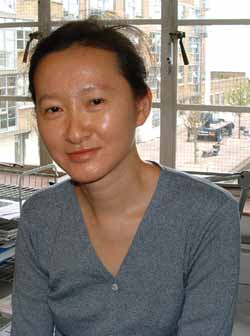
Wen was born in Malaysia and studied there until her O-levels, coming to the UK to study for her A-levels. At O-level, she took all the science subjects - maths, physics, chemistry and biology - and she continued along a science path for her A-levels, taking chemistry, physics and maths. "There wasn't any pressure", she says, "I was just quite good at those subjects, so it was natural that I continued with them."
Although she specialised in the sciences, Wen was also keen to study art. "Even at O-level, although the class that I was in wasn't doing art as a subject, I took art as an extra, just because I enjoyed drawing and painting. And at A-level, I helped friends who were doing the subject." She was sure she wanted to do something practical - "to do mathematics, or physics, or any of those subjects, as a pure academic subject at university level, was never my intention".
A stroke of luck
Wen didn't find her school's careers guidance much help: "I kind of fell through the gaps, because I was relatively good at my subjects at school", she says. In fact, it was luck that led her to architecture: "I spoke to the right people at the right time. I was talking to some of my cousins during a holiday, and they took me around the colleges to have a look at what they were doing. They took me to the Architectural Association in Bedford Square and that attracted me. I went to the end-of-year exhibition and it was pretty exciting, and I thought: 'That's what I'd like to do'."
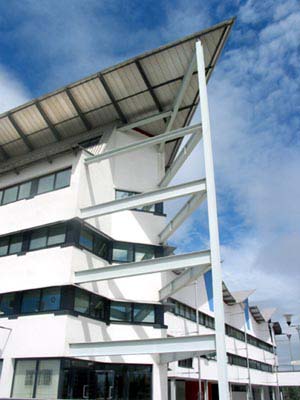
The new University of East London Docklands Campus designed in 1999 by Edward Cullinan Architects. Image courtesy of UEL
Wen did her A levels in 1980, and accepted an offer to study architecture from what was then the Polytechnic of East London, now the University of East London. It didn't seem to matter at interviews that she hadn't studied A-level art - in fact, no particular A-levels are required. It could be said that architecture is the true Renaissance subject - a fusion of art and science, theoretical and practical, pure and applied. As a result, the ideal education is a broad one, and it's probably best to combine arts and science subjects if you want to go on into architecture. Wen does say, though. that A-level maths is a very real advantage. It is useful to have technical drawing, and it is a good idea for students to begin with a Foundation arts year at University before doing the architecture course. The bottom line, she says, is that "it's very much what you say at the interview. I think I probably read up beforehand!"
It didn't occur to Wen at the time to study at the Architectural Association because it was - and still is - a private school. "I didn't really know very much about it so I thought maybe I should start with a university or polytechnic degree." But after a year at the East London Polytechnic, she decided to continue her education at the Architectural Association. Among other things, the flexibility of their course appealed to her. "It's not like a university where you have to finish the year or you're in a limbo. At the AA, if after one term you're not doing the coursework very well or you have to catch up, you can take a term out, provided you can find a tutor who'll take you on and monitor your progress."
A long road to travel
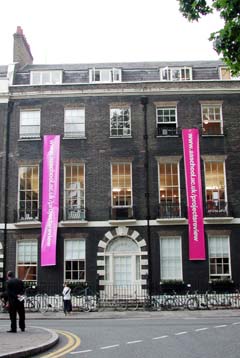
The Architectural Association in Bedford Square, London. Photo copyright Nicola Bailey/Architectural Association
In order to become a fully qualified architect, a student must pass three hurdles. The first - Part 1 - takes three years, and usually consists of a degree or diploma at a University. Then follows a year working in an architectural office, followed by another two years of study and another set of exams - Part 2. Then more work and on-site experience and yet another set of exams - Part 3. "It's quite strenuous", says Wen, "a bit like medicine, with a minimum of seven years".
Wen did things slightly differently. While studying for her Part 1 exams she worked part-time for tutors at the AA, and therefore didn't feel the need to take a year out before progressing to Part 2. Instead she continued straight on, spending four years in total at the AA, and finishing with her Part 2 exams.
"At Part 2 level you can't sign any legal contracts. You have to go out and work and get relevant on-site experience and then you do your Part 3 exams. You do a lot on the legal side of architecture, there's a bit about the planning stage. You're no longer examined on design and that, it's about the practice, it's things like what happens at the planning stage. You can't say you're an architect until after Part 3."
First stop after leaving the AA was a small practice run by an architect who had taught at the AA, where Wen spent one year. Then she moved to her current firm, Edward Cullinan Architects, where she spent another two years before getting her Part 3, "helping to run jobs, doing the day to day administration of a contract - that's what you have to learn".
A different way to work
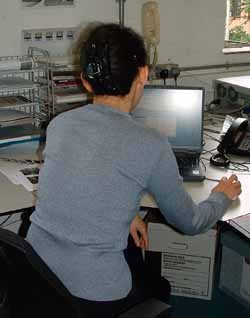
Wen working in the offices of Edward Cullinan Architects in London
Wen was always very clear about the path she wanted to follow. "In architecture there is a 'star system', big-name architects like Norman Foster", she says. "When you first qualify, you make a decision, do you want to go and work for one of these star architects and train up, or do you want to have a bit more independence in what you are let to do. I made a conscious decision not to work for these big practices with star architects, because I think you just get lost in that system, and there's a lot of competition. I thought there were other ways to explore how you can work."
A major factor in attracting Wen to Edward Cullinan Architects was the unusual structure of the firm. It is a cooperative, and everyone who works for the company in any role has the opportunity to become a member of the cooperative. This means that rewards are potentially greater when business is doing well, and everyone has a stake in the way the firm is run, but it also means that in a downturn, everyone shares the pain, perhaps taking paycuts. Along with this egalitarianism of ownership goes an egalitarianism of work. "We used to think that everybody should be able to do everything, from design to managing a big project, to the admin side. But the kind of projects that we take on are getting increasingly big, and you must simply accept that you can't do everything."
For Wen, size matters too. "I always try to avoid big companies, I always work for small to medium size companies, maximum around 30. For example, every Friday we [ECA] sit together and have lunch. You can get about 25 people comfortably around the table. It used to be that you could say that that determines the size of our office, because otherwise you can't go around the table, and you start to become like factions. We are an openplan office, so we like to be able to have everybody in one big room, just so that although on any project you will be working in teams. You learn from each other, the so-called knowledge transfer is easier."
Hard times
Around 1990, things changed abruptly, both for Wen and the profession in England - a major recession set in. Commissions dried up and architects were finding themselves without any work. Wen escaped by moving up to Edinburgh. "It was great. Architecture is a small world, you know everyone, especially in a place like Edinburgh."
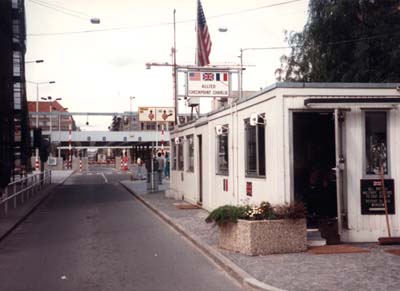
Checkpoint Charlie - a symbol of the old Berlin
But the recession spread and Edinburgh turned out to have been only a temporary reprieve. Fortunately for Wen, architecture travels well, and just as builders were sitting idle all over Britain, the world was witnessing one of the biggest urban building projects in history, as Berlin recreated itself after the fall of the Wall. So Wen moved to Germany, and worked for a medium-sized office in Berlin for six years, starting in 1992. "It was fantastic", she says. "I witnessed and was part of the design development stage of the city's reconstruction. I chose to go to that office because they were doing a lot of social housing. They have much more ambitious social housing programmes abroad. Standards are higher, people expect more."
Home again
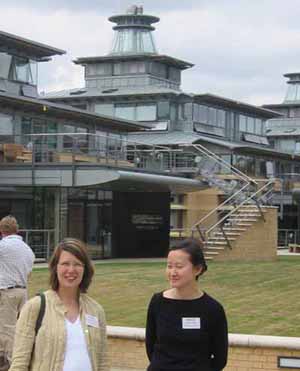
Wen Quek and fellow architect Kristina Roszynski at the Centre for Mathematical Sciences in Cambridge for the opening of the Betty and Gordon Moore library.
Photo Johnny Winter
In 1997, after seven years away, Wen returned to London and took up where she left off with Edward Cullinan Architects. The first project she worked on was the new Centre for Mathematical Sciences in Cambridge (where Plus is housed). "It was such an involved process. It took three years from the start to getting on site, so you do need a lot of patience. These things take time because we're dealing with a lot of money, a lot of commitment from everyone. A great number of people were involved."
On such a long project - the firm worked on the Centre for Mathematical Sciences for seven years - individual architects wouldn't usually be involved for more than about two or three years. "Unless that person really wants to do it, you've got to release people when the time is right. So people came in at different stages."
Wen's next project was again for a university - this time the Singapore Management University. "That was another huge project, completely different in that it was right in the middle of the city. Again it was contentious, so there were a lot of government bodies involved, so that was very challenging." She spent nine months working in Singapore with three colleagues. "It was good experience, but I missed being part of the cooperative."
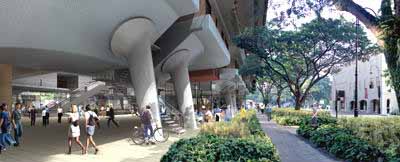
ECA's design for Singapore Management University. Image by Hayes Davidson
The philosophy of architecture
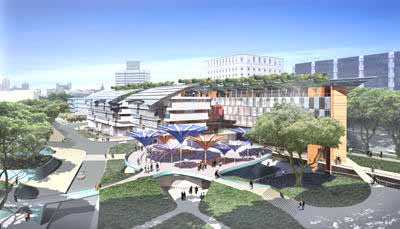
Bringing ideas to fruition.
ECA's design for Singapore Management University. Image by Hayes Davidson
As Wen talks about her work, she returns again and again to the theme of architecture as an ideas-driven discipline.
"For me it starts off with the idea of working with ideas," she says, "how to bring ideas to fruition, to reality, to fulfil social needs. Plus the fact that you're doing something with the built environment - it obviously affects lives. There is the client who commissions it but there are also the users, and they are different types of people. There's an element of creation - it's more than just drawing on paper."
The need to work with many disciplines and master many skills also appeals. Wen describes what an architect does as "bringing people together to work in a team to produce a result, rather than working on your own to produce something, like a pure artist."
Architecture and mathematics
On the subject of the relevance of mathematics to architecture, Wen makes two quite different points. The first is that quite a bit of mathematics is directly useful to architects - "measurement, the fact that we're dealing with geometry, that when you draw something you are thinking in 3-d. Similarly you do a lot of trigonometry, you're dealing with pure shapes. And when you go on site, the architect is always responsible for setting out. You have to place the building, by drawing a plan, using coordinates.
"As architects we have to look at numbers and graphs all the time - schedules, areas, costs, budgets. On small projects you can deal with the money side of things. And accuracy is important - you have to be right."
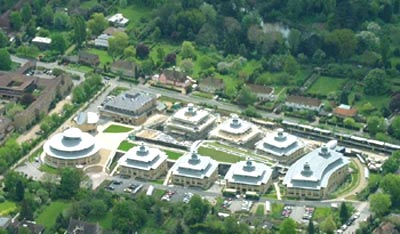
A happy marriage of architecture and mathematics - the Centre for Mathematical Sciences in Cambridge. Photo courtesy of the Faulkes Flying Foundation
But her second point is more intangible, and returns to her theme of architecture as a discipline of ideas. "It's to do with working in the abstract. When you start a project you have all these ideas floating around, and you have to grapple with them. You need a discipline to bring these things together, and the reasoning and persistence to get to the best solution for the site.
"You always start off with too many ideas. The client will come to you with a brief, so there are certain set parameters - budget, structure, services - all the things we have to incorporate to make a building work. And then you go to see the site, so that sets parameters as well. Maybe some of the parameters are assumptions - maybe wrong assumptions - so you have to test, to challenge. We have what we call 'testing the hypotheses' - the brief against the site, the budget, against what your other consultants are telling you on the structure and services side. When you're doing architecture, and you come to an appropriate solution, it's very similar to the joy we get out of solving an equation."
So is now a good time to be an architect? "It's always a good time to be an architect. The kind of skills you learn as an architect make you adaptable, flexible, and maths has a lot to do with it."
About this article
Helen Joyce is editor of Plus. For this article, she interviewed architect Wen Quek at the offices of Edward Cullinan Architects in London.